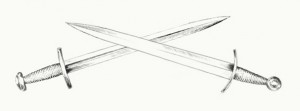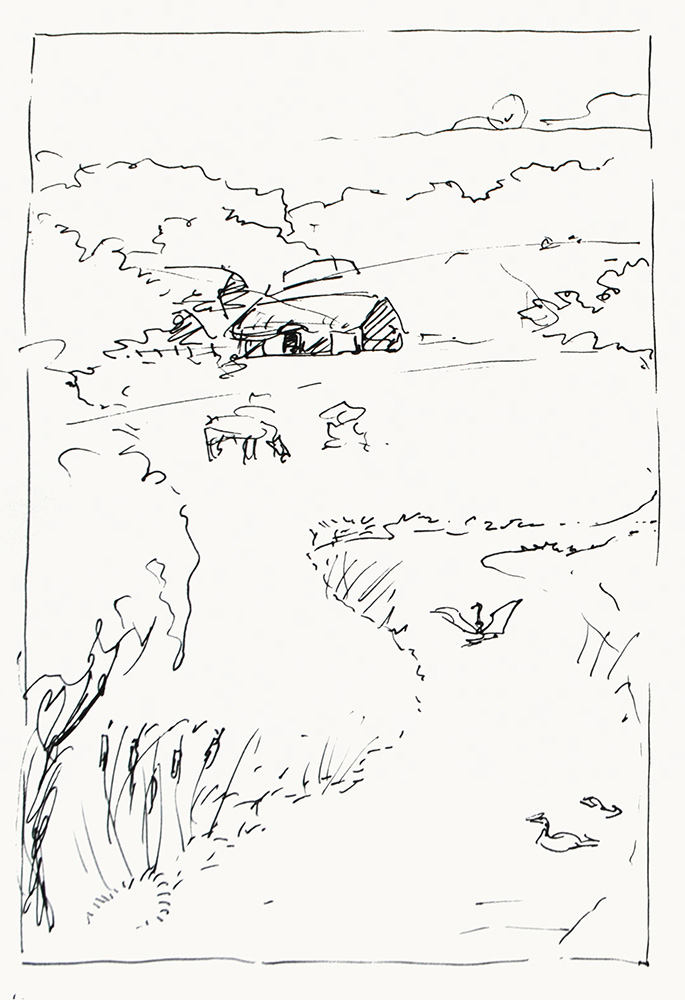Questions may naturally arise. (Remember, however, that Ragaris is not an ideal society. It is also not merely medieval, but medieval Christian. I make no apology, for example, for retaining the institution of marriage.)
For example:
If all trades are open to both sexes, who looks after the children? The rich on Ragaris have servants to manage childcare. The poor cope as best they can. However, most villages, landed estates and towns (which together house most of the population) provide one or more “childpens”. These are described in the book as places “where children too young to be useful fought and played and learned to obey adults, thus freeing their parents for trade or profession or service.” They are funded on a basic level by market dues, the local lord, or charitable donation, although superior childpens may charge fees. They may be located in the corner of a barn, or in a church, or a purpose-built shed. They would not pass an OFSTED inspection. The aim is for the children still to be alive at the end of the day.
Women normally being shorter and physically weaker than men, can they realistically fight alongside and against them? Most men have an advantage over most women in combat. But a tall strong woman is taller and stronger than a small man, and armies have never insisted on only recruiting from the strongest. In a society where women are not restricted to the home and there is no concept of chivalry, there has been good reason to develop combat techniques, along the lines of judo, for the lighter physique. Not all weapons require enormous strength. Few people on Ragaris have the luxury of choosing a career: of those who can, fewer women than men choose the military, but some do, and in times of emergency, the call is for all who are available. Ragaris is a violent society, but less violent and war-ridden than actual medieval Europe. Whether this is because power is shared between the sexes, I cannot say.
Does this mean that all the main characters in the stories are female? No. “We Do Not Kill Children” is the story of a man and his friends and enemies, male and female.
What other questions occur to you? Please comment below, and see if I can find an answer.



Malachi Malagowther
30th November 2015 at 8:54 pmAre there any great historical women warriors in Ragaris? In Irish mythology a woman warrior trains the great warrior Cuchulain. Did she provide a role model for the women of Ragaris?
Penelope Wallace
1st December 2015 at 1:32 pmPossibly. Some legends of Ancient Greece and Rome, Ireland and Britain probably reached Ragaris with the monks and nuns who brought them Christianity. One very powerful woman leader in early Ragaris was St Ansha, after whom the city of Vachansha in Defardu is named; but I do not currently have much detail as to her life.
Stephen Sheridan
5th December 2017 at 7:26 pmDear Penelope
I am looking forward to reading your book and I am very intrigued by the concept. I assume from the website that your world had gender equality prior to the landing of the Christians, in which case was there an existing polytheistic religion and how is that regarded in the timeline of your narrative? How did the arriving Christians switch from a male-dominated society (assuming they came from a version of our own world) and why did they not date from AD rather than their own landing? Did the Christians also bring technology with them and does the continent have established trade with other landmasses?
I agree with your blog viewpoints on so-called feminist films which simply think making an action hero female makes it feminist. I found the first new Star Wars film a bit lacking because it was just a plot repeat substituting a female for a male lead (well played though the actress made it). I much preferred the Love and Friendship (an adaption of Jane Austen’s Lady Susan), which had me fascinated (and laughing so much that my wife told me off foe shaking the seats). If there were more women writing, directing and producing films in Hollywood, not only would we have less Harveys, but also more interesting films than the deluge of tedious and repetitive superhero movies.
All the best and more power to your elbow.
Stephen
Penelope Wallace
8th December 2017 at 2:19 pmDear Stephen
Thank you for this. I haven’t delved deeply into the pre-Landing world or religious life of Ragaris, although there are standing stones in Marod, “put there by long ago people”, which are associated in popular mythology with death.
What I know is that Christianity was brought to the continent of Ragaris by a boatload of monks and nuns from Ireland in the Dark Ages, a time when the Irish were great sea-farers. One of the most prominent of their converts was a female warrior/leader called Ansha, later canonised and the most revered Ragari saint. (There is a city called Vach-ansha named after her.) Whether the whole society was gender-equal at the time or whether it was just more equal (and possibly more peaceful) than Europe and also took on the New Testament implications of the value of all people, I don’t know. There was controversy, and it took a second Great Synod in 181 After Landing to establish that female equality is orthodoxy, and male supremacy is heresy. This is referenced very briefly in the second book.
There does not seem to be any trade with the outer world, and all influences seem to be inward, possibly from shipwrecked mariners. The population is mixed-race, but the aboriginal inhabitants were probably related to the Amerindians.
I don’t want to write about the arrival of Cortes, and his like.
Stephen Sheridan
9th December 2017 at 11:02 pmThanks Penelope. We certainly need more books like yours – I have a thirteen year-old daughter and trying to get her interested in books beyond anything to do with animals is quite hard at the moment. While I understand that you don’t want to write about the arrival of a Cortes-like expedition, it would make a challenging climax to a saga like yours since your world would be better able to defend itself ideologically and technologically and it would be fascinating to observe the impact of encountering such a society on the “our world” people of the middle ages.